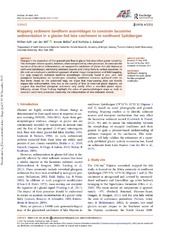Mapping sediment–landform assemblages to constrain lacustrine sedimentation in a glacier-fed lake catchment in northwest Spitsbergen
Peer reviewed, Journal article
Published version

Åpne
Permanent lenke
https://hdl.handle.net/1956/11773Utgivelsesdato
2015-10-24Metadata
Vis full innførselSamlinger
- Department of Earth Science [1050]
Originalversjon
https://doi.org/10.1080/17445647.2015.1113391Sammendrag
Changes in the deposition of fine-grained rock-flour in glacier-fed lakes reflect glacier variability. This meltwater-driven signal is, however, often overprinted by other processes. To constrain the signature of lacustrine sedimentation, we mapped the catchment of glacier-fed Lake Hajeren in northwest Spitsbergen, identifying sediment sources and linking them to surface processes. To this end, we employed a combined approach of aerial image interpretation and field mapping. Our map comprises sediment–landform assemblages commonly found in pro-, peri- and paraglacial landsystems on Spitsbergen, including weathered moraines outboard Little Ice Age limits. Based on the presented map, we argue that mass-wasting does not directly impact lake sedimentation. Also, due to the scarcity of fines in historical glacial deposits, we suggest that modified glacigenic sediments only briefly affect a recorded glacier signal, following retreat. These findings highlight the value of geomorphological maps as tools to constrain catchment processes, improving the interpretation of lake sediment records.
